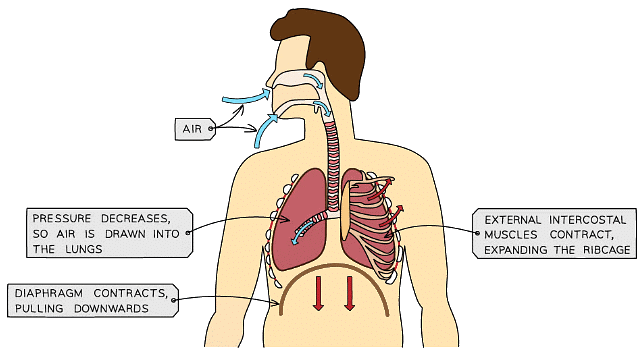Grade 10 Exam > Grade 10 Notes > Biology for Grade 10 > Lungs
Lungs | Biology for Grade 10 PDF Download
Adaptations for gas exchange
- All gas exchange surfaces have features to increase the efficiency of gas exchange including:
- Large surface area to allow faster diffusion of gases across the surface
- Thin walls to ensure diffusion distances remain short
- Good ventilation with air so that diffusion gradients can be maintained
- Good blood supply (dense capillary network) to maintain a high concentration gradient so diffusion occurs faster
- Remember that gas exchange occurs by the process of diffusion; breathing is essential in maintaining high concentration gradients between the air in the alveoli and the gases dissolved in the blood
- In particular, breathing keeps the oxygen level in the alveoli high and the carbon dioxide level low
Structures & functions of the lungs

Each lung contains around 250 - 300 million alveoli, with the total surface area of each lung being around 70m2
Structure & function lungs table

Ventilation of the lungs
- Air passes through the following structures when we breathe in:
- Trachea
- Bronchus (plural: bronchi)
- Bronchiole
- Alveoli (the site of gas exchange where oxygen diffuses into the blood and carbon dioxide diffuses out)
- The diaphragm is a thin sheet of muscle that separates the chest cavity from the abdomen; it is ultimately responsible for controlling ventilation in the lungs
- When the diaphragm contracts it flattens and this increases the volume of the chest cavity (thorax), which causes a decrease in air pressure inside the lungs relative to outside the body, drawing air in
- When the diaphragm relaxes it moves upwards back into its domed shape and this decreases the volume of the chest cavity (thorax), which causes an increase in air pressure inside the lungs relative to outside the body, forcing air out
- The external and internal intercostal muscles work as antagonistic pairs (meaning they work in different directions to each other)
- During inhalation the external set of intercostal muscles contract to pull the ribs up and out:
- This also increases the volume of the chest cavity (thorax), decreasing air pressure, drawing air in
- During exhalation, the external set of intercostal muscles relax so the ribs drop down and in:
- This decreases the volume of the chest cavity (thorax) increasing air pressure, forcing air out
- When we need to increase the rate of gas exchange (for example during strenuous activity) the internal intercostal muscles will also work to pull the ribs down and in to decrease the volume of the thorax more, forcing air out more forcefully and quickly – this is called forced exhalation
- There is actually a greater need to rid the body of increased levels of carbon dioxide produced during strenuous activity!
- This allows a greater volume of gases to be exchanged
Inhalation

Breathing in
- external intercostal muscles contract
- ribcage moves up and out
- diaphragm contracts and flattens
- volume of thorax increases
- pressure inside thorax decreases
- air is drawn in
Exhalation
 Breathing Out
Breathing Out
- external intercostal muscles relax
- ribcage moves down and in
- diaphragm relaxes and becomes dome-shaped
- volume of thorax decreases
- pressure inside thorax increases
- air is forced out
The document Lungs | Biology for Grade 10 is a part of the Grade 10 Course Biology for Grade 10.
All you need of Grade 10 at this link: Grade 10
|
110 videos|93 docs|9 tests
|

|
Explore Courses for Grade 10 exam
|

|
Signup for Free!
Signup to see your scores go up within 7 days! Learn & Practice with 1000+ FREE Notes, Videos & Tests.
Related Searches
















